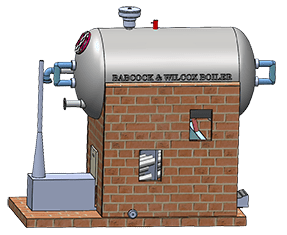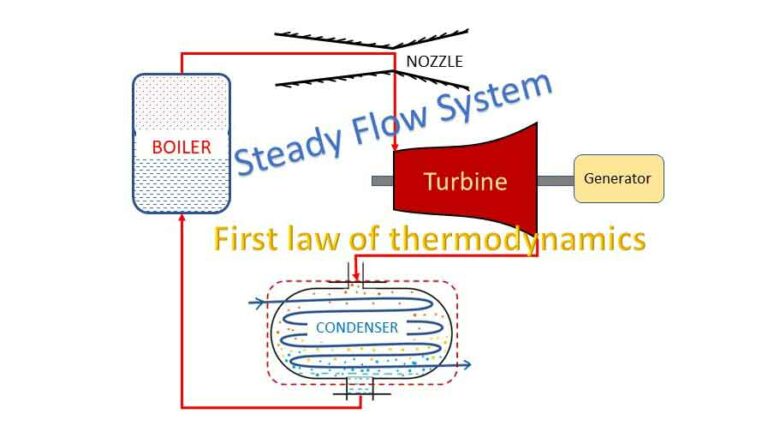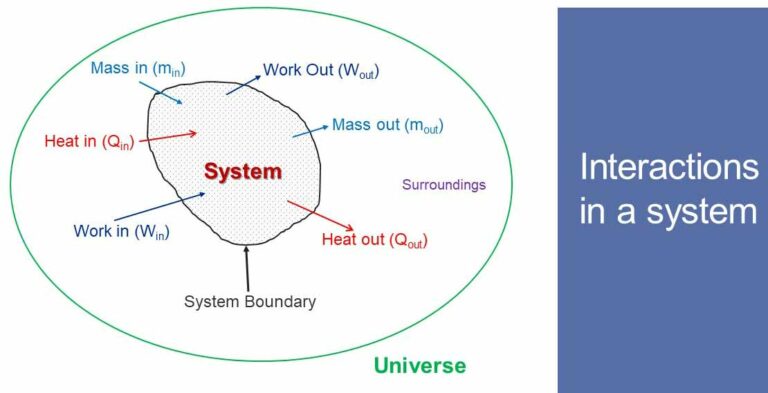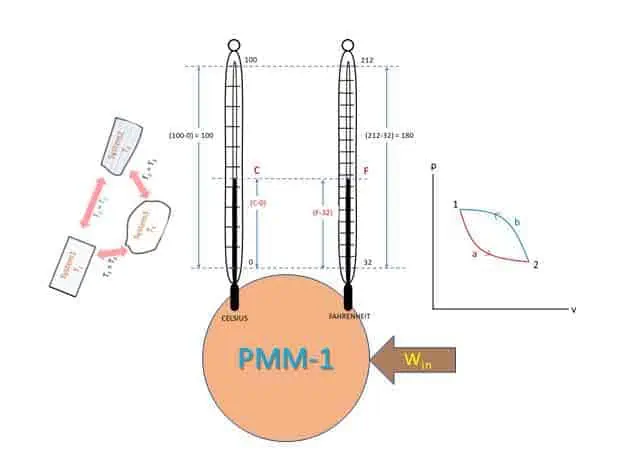Introduction
Stephen Wilcox and George Herman Babcock patented the Babcock & Wilcox Boiler in 1867. This Boiler used water tubes to generate steam at higher pressure more safely and efficiently. The Babcock & Wilcox Company was an American renewable, environmental and thermal energy technologies and service provider and had operations in many international markets across the globe.
Applications
- Power Plant for generation of electricity.
- Industries for process Steam.
Babcock and Wilcox Boiler is Classified as a Horizontal Axis, Multiple Water tube, Natural Circulation, Externally Fired, Medium Pressure, Stationary Boiler.
Construction
All the parts except the furnace, are hung by means of metallic strap or belt supported on pillars. Babcock and Wilcox Boiler consists of following parts:
- Steam and Water Drum
- Water Tubes
- Headers (Down take and Uptake)
- Baffles
- Super heater
- Inspection Door
- Furnace and Grate
- Mud Collector (Box)
- Damper
- Mountings and
- Accessories
Specifications
- Drum diameter = 1.22 to 1.83 m
- Overall Length = 6.096 to 9.144 m
- Diameter of the Super-heater tubes = 3.84 to 5.71 cm
- Steaming Capacity = 40,000 kg/h (max)
- Diameter of the water tubes: 7.62 to 10.16 cm
- Efficiency = 60% to 80%.
- Working pressure = 140 bar (max)
Schematic Diagram

1. Steam and Water Drum
It is also known as Steam drum. The horizontal axis drum contains both water and steam. About half of the drum is occupied by steam. There are two short tubes connected to the Uptake Header (Riser) and Down take Header from bottom of the Steam and Water Dum.
2. Water Tubes
Babcock and Wilcox Boiler is multiple Water Tube Boiler. The Water Tubes connect the uptake header and the down take header. These tubes are inclined at an angle of about 15o for easy separation of steam and water by establishing circuit of convective current. Steam enters the drum through the uptake Header and cold water come down to the tubes through the down take Header.
3. Uptake Header
Uptake Header is situated at the front end and above the Furnace of the boiler and connected to the drum by a short tube (riser). Steam enters the drum easily due to density difference with that of water.
4. Down take Header
This is situated at the Chimney end of the boiler and connects to the bottom of the drum by another short tube (longer than the riser). Water flows down from drum to the Down take Header and then towards the Uptake Header to occupy the space vacated by water moving up to the drum.
5. Grate and Furnace
Grate is the platform for burning the solid fuel. The opening on the grate is essential for settling the bottom ash on the Ashpit below the Grate. The furnace is placed under the uptake header where the fuel is burnt.
6. Fire Door
Fire Door is for feeding the fuel to the Grate of the furnace to burn solid fuel. The air required for combustion of fuel can also enter the furnace.
7. Baffle Plates
The Baffle plates are the deflectors to the flow of combustion gas from furnace to the Chimney. These plates or obstructions cause hot gases to move upwards and downwards in a Zig-Zag path before entering the Chimney. If the Baffles plates are not provided, flue gas flow would be short circuited to Chimney taking the shortest path. The heat transfer to the water tubes would be less and more heat would be carried away by the exhaust gases (lower boiler efficiency).
8. Mud Box
Muds, being heavier than the water are collected on the bottom part of the Boiler. A Mud Box is therefore, provided at the bottom of the down take header. Muds, settled down inside the Box are thrown out due to Boiler pressure while the Blow off Cock is opened periodically.
9. Damper
A Damper controls the rate of flow of the smokes from the boiler to the chimney via Smoke Box. If the flow of smokes to the chimney is restricted, less air would enter inside the furnace. Indirectly a Damper controls the rate of formati16on of steam by regulating the combustion of fuel by controlling the entry of fresh air inside the furnace (Boiler Draught or Draft).
A damper is operated by a chain that passes over a pulley to regulate the draught. It thus regulates the combustion of fuel by controlling the entry of air into the furnace.
10. Mountings and Accessories
This high pressure Boiler is equipped with all mountings like Safety Valve, Steam Stop Valve, Water Level Indicator, Pressure Gauge etc. Super heater and economiser can be fitted to increase the efficiency of Boiler and quality of steam.
Working of Babcock and Wilcox Boiler:
Coal is fed to the grate through the fire door and is burnt. The combustion gas expand, move upward, and pass across the water tubes. The baffle Plates deflect the flue gases and therefore the flue gases travel in a zig-zag way across the water tubes and the superheater. The exhaust gases leave the Boiler and enters the Smoke Box to be discharged to the atmosphere through the chimney. The super heater is so placed within the combustion chamber that superheater tubes can receive heat from the combustion gas.
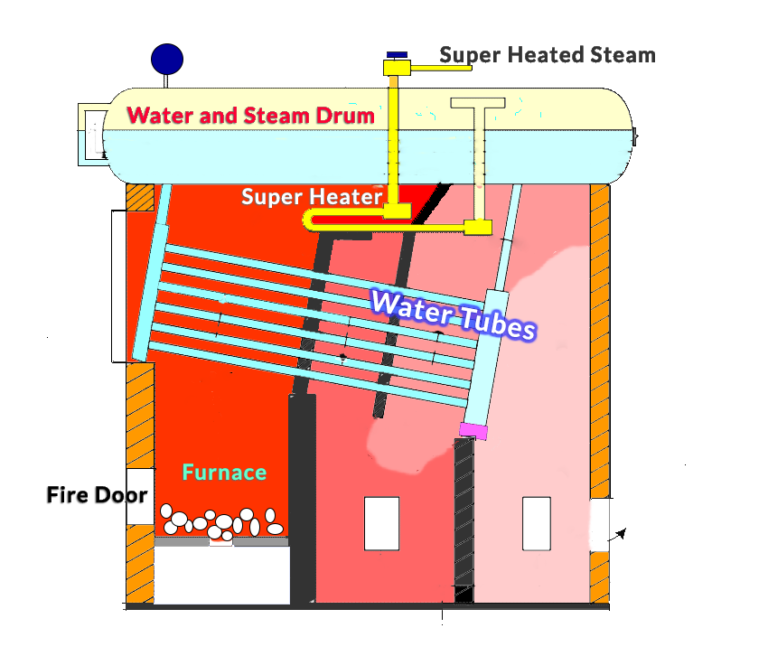
The tubes just above the Furnace receive more heat and temperature is slightly more than the rest of the tubes. The water become lighter (lower density) and goes up to the Drum through the Uptake Header (Convection). The Water from the Drum comes down through the Down take Header into the tubes and flows towards the uptake Header. Thus, a circuit of convective current is established, and the inclination of the tubes helps the flow of waters of different densities. This type of continuous circulation of water is known as natural circulation.
The steam formed is collected in the Drum above the water surface. The steam is collected from the steam space through the Anti priming Pipe which is the sent to the Super Heater. The steam absorbs more heat from the hot gases and become Superheated. The super-Heated steam passes through the Steam Stop Valve at the top of the Drum. At the lowest point of the boiler, the mud and sediments are collected which is Blown out through the Blow Off Cock periodically.
You can watch this video for Anti-priming pipe in Boiler
All mountings like Steam Stop Valve, Safety Valve, Water Gauge, Pressure Gauge, Feed Check Valve, Fusible Plug etc are attached to the Boiler for safe operation. Economiser may be placed inside the smoke box to preheat the feed water by absorbing the waste heat.
You may consider watching the following video for Working principle of Babcock and Wolcox Boiler
Advantages
- High rate of Steam generation (about 40,000kg/hr)
- High pressure (about 140 bar) high temperature superheated steam is suitable for steam turbine.
- Occupies less space.
- Easy cleaning, inspection, and repair of parts.
- Boiler tubes can be easily replaced without effecting other components.
- Parts can be separated and transported easily.
- The overall efficiency is high (more heating surface of multiple water tubes).
- Draught Loss is less.
Disadvantages
- Maintenance cost is higher.
- Demineralised Feed Water is required (otherwise, scale may be formed inside the tube causing less heat transfer to water leading to overheating and bursting.
- Continuous Water feeding is necessary.
- Constant monitoring of Water level must be ensured to avoid any damage.

